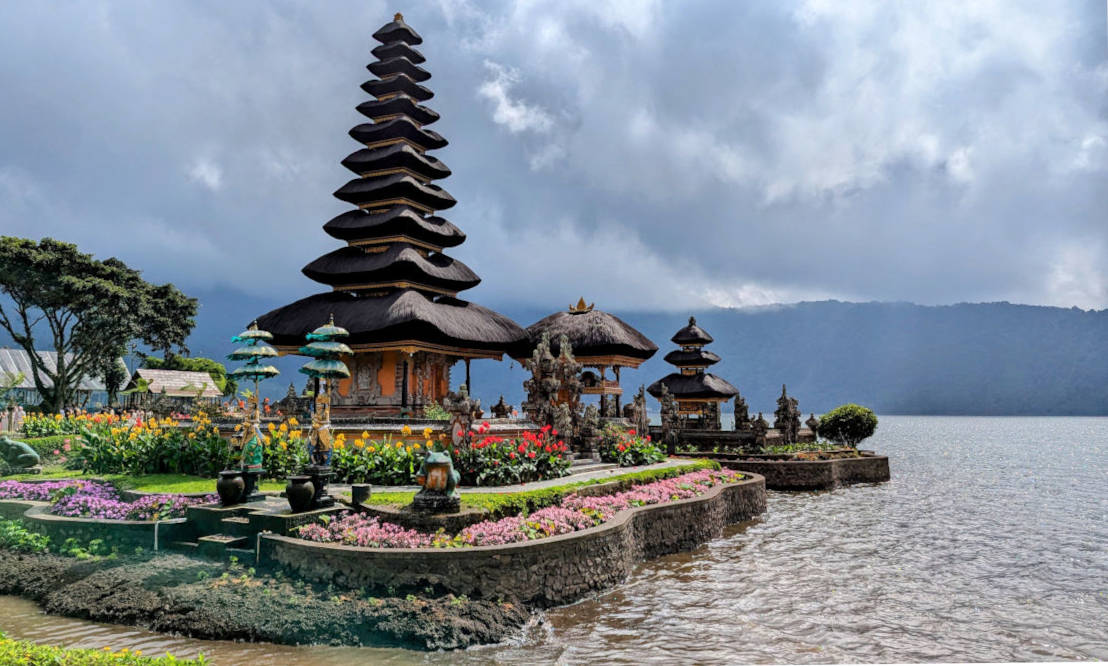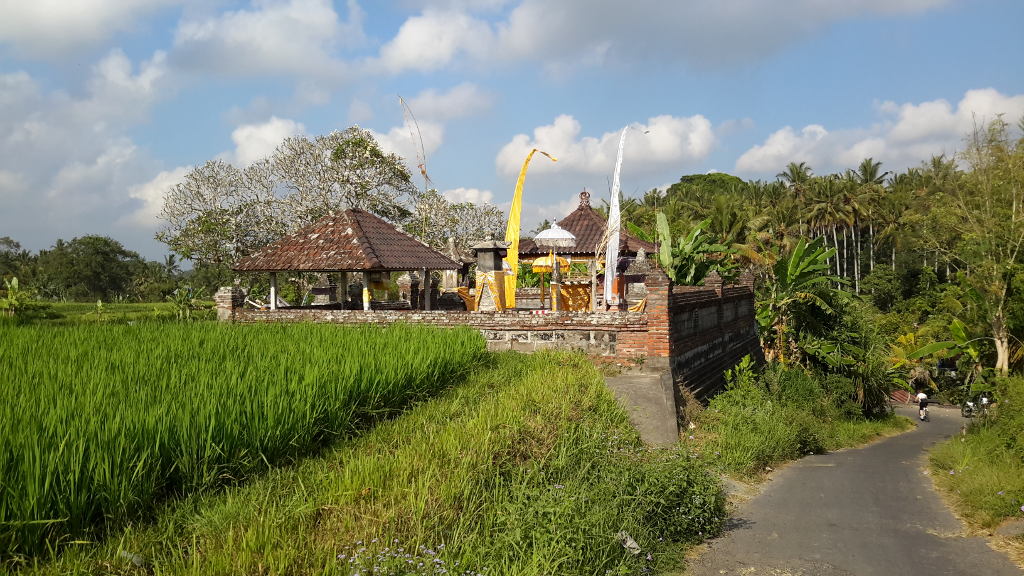
Water Temples in Bali: Merging Religion and Science

Peter Prevos |
1751 words | 9 minutes
Share this content
Winter in southern Australia is a time to escape to more tropical locations and soak up some sun. We decided to spend a week in Bali, the most popular tourist destination in the Southern Hemisphere. Even though this was a holiday, I could not resist taking a bike ride through the sawahs to view works of colonial Dutch water engineering and the famous water temples in Bali. We also journeyed from the top of the catchment, down the rice paddies, to the final temple at the ocean. The flow of water in Bali is guided by weirs, channels, and gravity, as well as by a sequence of water temples.
These water temples provide a fascinating insight into how farmers combine religion and engineering to manage water. This article discusses how the Balinese synthesise rational engineering with the social and spiritual dimensions of water to optimise their rice harvests. It relies on the extensive work of American anthropologist Stephen Lansing, who has studied Balinese irrigation systems for decades.

Water Temples in Bali
Bali is famous worldwide for its magnificent green sawahs that cling to the steep hills. Farmers irrigate rice paddies through a terraced system of faceted paddocks. An intricate network of channels originates from springs and lakes in the volcanic mountain range. The water slowly flows from the highlands to the ocean, irrigating the fields down the slopes.
This complex irrigation system existed centuries before the Dutch colonial powers introduced mathematical principles in water management. What the temporary Dutch overlords of Bali did not realise was that this intricate system for water management was not merely a triumph of rational engineering but an organically organised complex system for managing natural resources.
The primary organising units of the Balinese irrigation system are the subaks. These are religious and social organisations that coordinate everything related to the cultivation of rice, including irrigation. The subak system has continually evolved over the past thousand years to accommodate new circumstances. In 2012, the cultural landscape of Bali was given World Heritage status by UNESCO in recognition of its unique integration of religion, farming and ecology.
A Subak is a collective of farmers within an irrigation district congregating around water temples. The subaks are democratic organisations where farmers and priests discuss their irrigation strategy. The water temples follow the logic of the flow of water from the head of the catchment along springs, rivers and the irrigation channels that weave their path through the landscape.
The primary water temple is the Pura Ulun Danu Batur, located along the rim of Lake Batur's crater in the Balinese mountains. A network of regional water temples cascades from this upstream temple, each controlling a section of the irrigation system.

The Ulun Suwi (Head of the Terraces) temples coordinate irrigation for a group of subaks. Most subaks have a Ulun Carik (Head of the fields) temple where farmers perform rituals and hold meetings to manage the systems.
Each framer also had a Bedugul, a shrine at the place where the water first entered his fields. This hierarchical system of temples ensures that decisions about water are made at strategic points in the system. The regular rituals accompany the water with blessings and offerings from the head of the catchment down to the place where it is converted to rice and down to the ocean.
The Balinese irrigation system is unique because it combines rational water management with religion. Such a combination seems contradictory in a world dominated by scientific thinking.
That the traditional system is effective became apparent when the Indonesian government implemented a Green Revolution in the 1970s. This revolution introduced scientific thinking to agriculture in Indonesia. This policy reduced the role of the Balinese water temples, which were invisible to the Western consultants. This well-intended policy disturbed the delicate balance that developed over the centuries. With the introduction of scientific farming, pests returned, and rice yields plummeted. Fortunately, the Indonesian government recognised these problems. It rescinded the orders to use specific seeds and chemicals in 1988, allowing farmers to return to their old practices.
The religious dimension of this system competes directly with the scientific mindset of water managers. Even though I am a staunch atheist and a rational water engineer, the Balinese experience shows that religion and engineering are not necessarily diametrically opposed. Both dimensions of the human experience collaborate to ensure the Balinese irrigation system thrives.

Religion and water
Balinese irrigation is strongly interlinked with the island's natural environment, both material and spiritual. Religion is influential in managing Balinese water, mediated through the network of water temples and priests.
Subak members collaborate to decide on water allocations and the timing of water supply, supported by rituals mediated by priests. The performance of these rituals is of critical importance in Balinese water management. The system does not rely on divine intervention, but the rituals create a strong sense of collective purpose. The water rituals are closely linked to observations of the natural environment and managed through a complex calendar system.
The word ritual is often used in a negative sense as being a pointless, repetitive action. However, a well-performed ceremony is a means to connect the sacred with the profane. The performance of ritual sacralises the natural environment, lifting it beyond the status of a resource exploited to maximise return to one with intrinsic meaning. On a more practical level, the ritual structure often contains practical knowledge that helps the locals optimise their decisions. This knowledge is developed over millennia of observation and trial and error. In this way, religion becomes a way to encode water management practices, just as mathematics is a way to encode knowledge.

The most crucial decision for farmers is when to plant rice. Flooding the paddocks alters the soil's chemical and biological properties, and the success of irrigation depends on accurately judging the seasonal flow of rivers and springs.
Rice has to be irrigated at the right time to maximise yield. The ritual calendar determines the timing of planting. The timing of the nyunsung ceremony is the most critical moment in the farming calendar as it signifies the start of the planting season. Selecting the right time optimises rainfall and sunshine, allows the harvest to occur in the dry time, and minimises pest populations.
The key to Balinese water management is the way they measure time. The Balinese calendar is a complex interaction between two ways to measure time's passage. The first is uku, a 210-day calendar independent of astronomical events. It is not a coincidence that the length of this calendar is the same as the growth cycle for Balinese rice. The second calendar follows the lunar phases, meaning a particular month does not always start on the same solar day.
The temple priest decides the timing to optimise the date for planting rice. In some places, the ideal day is marked by the appearance of a particular moss on an old tree, the presence of a type of grass, or the colour of the sea.
The knowledge required to manage the Balinese irrigation system is embedded in the island's Hindu mythology. A myth is not necessarily a story that is factually untrue. Mythology has several levels of interpretation. On the surface, mythological stories are fictional and irrational accounts of gods and the supernatural. Below this superficial view, myth contains practical and philosophical knowledge obtained through centuries of experience with the land.
The contemporary scientific approach to managing a complex Balinese irrigation system would be deploying thousands of sensors around the island and crunching numbers using sophisticated computer models. This approach is, however, similar to how the Balinese system has evolved. Over the centuries, farmers and priests have observed how nature impacts their farming. The mythological system has no underlying theory, but knowledge emerges from long-term observations and is wrapped in narrative instead of mathematical formulas.
Lansing and Kremer, who developed a computer model of the Balinese system, showed that it leads to optimised results. The model simulates the behaviour of farmers to see how such a system evolves. When the model starts with a random pattern, it develops into a situation resembling the Balinese system over time. This model shows how religious doctrine can contain scientific information, leading to an optimised model.
Water Engineering and the Horizon of Reason
We can extract scientific knowledge from the Balinese religious system, but what about the religious dimension itself? This article does not make any claims about the ontological validity of the supernatural claims in Balinese Hinduism. Whether or not the Balinese water goddess Dewi Danu exists is irrelevant.
Religious symbolism and mythology convey traditional knowledge about the local environment. Bali's religious traditions have evolved over the centuries to eventually develop a coherent system for managing natural resources. The spiritual dimension not only contains practical knowledge but also is the social structure that enables farmers to cooperate consistently and rationally through the hierarchical system of temples. Furthermore, the spiritual dimension of Balinese water management ensures that the resource has intrinsic value beyond its utilitarian purpose of growing rice.
The Balinese Subak system is a living example of how a decentralised water management approach can be instrumental in avoiding a Tragedy of the Commons, as described by Nobel Prize winner Elinor Ostrom. Managing a natural resource without any coordination from above will lead to its depletion.
Economists traditionally believe that the 'invisible hand' will guide us if everybody maximises their self-interest. Ostrom showed that this approach is not suitable for natural resources. When users collectively manage natural resources, they establish rules over time that sustainably control their resources, both economically and ecologically. In Bali, the subak system optimises land and water use. We could say that the Balinese water goddess is the invisible hand that guides the self-interest of the farmers.
Combining local religion with engineering places Balinese water management on the Horizon of Reason. The Balinese water temples illustrate how managing water is more than a volume of H2O controlled by engineering. Water has an inherent social dimension that water managers should pay attention to. Engineers often express water in cubic meters and milligrams per litre. For the people using the water, it has a much richer meaning that goes far beyond what we can express in numbers.

Share this content


